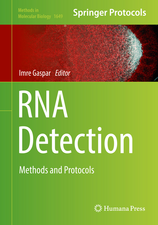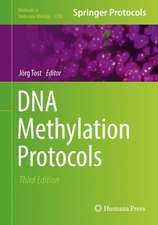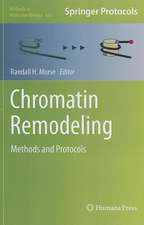DNA Electrophoresis Protocols for Forensic Genetics: Methods in Molecular Biology, cartea 830
Editat de Antonio Alonsoen Limba Engleză Paperback – 23 aug 2016
| Toate formatele și edițiile | Preț | Express |
|---|---|---|
| Paperback (1) | 1036.63 lei 6-8 săpt. | |
| Humana Press Inc. – 23 aug 2016 | 1036.63 lei 6-8 săpt. | |
| Hardback (1) | 735.46 lei 6-8 săpt. | |
| Humana Press Inc. – 3 dec 2011 | 735.46 lei 6-8 săpt. |
Din seria Methods in Molecular Biology
- 9%
 Preț: 791.63 lei
Preț: 791.63 lei - 23%
 Preț: 598.58 lei
Preț: 598.58 lei - 20%
 Preț: 882.98 lei
Preț: 882.98 lei -
 Preț: 252.05 lei
Preț: 252.05 lei - 5%
 Preț: 802.70 lei
Preț: 802.70 lei - 5%
 Preț: 729.61 lei
Preț: 729.61 lei - 5%
 Preț: 731.43 lei
Preț: 731.43 lei - 5%
 Preț: 741.30 lei
Preț: 741.30 lei - 5%
 Preț: 747.16 lei
Preț: 747.16 lei - 15%
 Preț: 663.45 lei
Preț: 663.45 lei - 18%
 Preț: 1025.34 lei
Preț: 1025.34 lei - 5%
 Preț: 734.57 lei
Preț: 734.57 lei - 18%
 Preț: 914.20 lei
Preț: 914.20 lei - 15%
 Preț: 664.61 lei
Preț: 664.61 lei - 15%
 Preț: 654.12 lei
Preț: 654.12 lei - 18%
 Preț: 1414.74 lei
Preț: 1414.74 lei - 5%
 Preț: 742.60 lei
Preț: 742.60 lei - 20%
 Preț: 821.65 lei
Preț: 821.65 lei - 18%
 Preț: 972.30 lei
Preț: 972.30 lei - 15%
 Preț: 660.49 lei
Preț: 660.49 lei - 5%
 Preț: 738.41 lei
Preț: 738.41 lei - 18%
 Preț: 984.92 lei
Preț: 984.92 lei - 5%
 Preț: 733.29 lei
Preț: 733.29 lei -
 Preț: 392.60 lei
Preț: 392.60 lei - 5%
 Preț: 746.26 lei
Preț: 746.26 lei - 18%
 Preț: 962.66 lei
Preț: 962.66 lei - 23%
 Preț: 860.22 lei
Preț: 860.22 lei - 15%
 Preț: 652.64 lei
Preț: 652.64 lei - 5%
 Preț: 1055.50 lei
Preț: 1055.50 lei - 23%
 Preț: 883.87 lei
Preț: 883.87 lei - 5%
 Preț: 1141.13 lei
Preț: 1141.13 lei - 19%
 Preț: 491.89 lei
Preț: 491.89 lei - 5%
 Preț: 1038.86 lei
Preț: 1038.86 lei - 5%
 Preț: 524.16 lei
Preț: 524.16 lei - 18%
 Preț: 2122.34 lei
Preț: 2122.34 lei - 5%
 Preț: 1299.23 lei
Preț: 1299.23 lei - 5%
 Preț: 1339.12 lei
Preț: 1339.12 lei - 18%
 Preț: 1390.26 lei
Preț: 1390.26 lei - 18%
 Preț: 1395.63 lei
Preț: 1395.63 lei - 18%
 Preț: 1129.65 lei
Preț: 1129.65 lei - 18%
 Preț: 1408.26 lei
Preț: 1408.26 lei - 18%
 Preț: 1124.92 lei
Preț: 1124.92 lei - 18%
 Preț: 966.27 lei
Preț: 966.27 lei - 5%
 Preț: 1299.99 lei
Preț: 1299.99 lei - 5%
 Preț: 1108.51 lei
Preț: 1108.51 lei - 5%
 Preț: 983.76 lei
Preț: 983.76 lei - 5%
 Preț: 728.16 lei
Preț: 728.16 lei - 18%
 Preț: 1118.62 lei
Preț: 1118.62 lei - 18%
 Preț: 955.25 lei
Preț: 955.25 lei - 5%
 Preț: 1035.62 lei
Preț: 1035.62 lei
Preț: 1036.63 lei
Preț vechi: 1091.19 lei
-5% Nou
Puncte Express: 1555
Preț estimativ în valută:
198.38€ • 215.41$ • 166.64£
198.38€ • 215.41$ • 166.64£
Carte tipărită la comandă
Livrare economică 22 aprilie-06 mai
Preluare comenzi: 021 569.72.76
Specificații
ISBN-13: 9781493962198
ISBN-10: 1493962191
Pagini: 394
Ilustrații: XIII, 394 p.
Dimensiuni: 178 x 254 mm
Greutate: 0.71 kg
Ediția:Softcover reprint of the original 1st ed. 2012
Editura: Humana Press Inc.
Colecția Humana
Seria Methods in Molecular Biology
Locul publicării:Totowa, NJ, United States
ISBN-10: 1493962191
Pagini: 394
Ilustrații: XIII, 394 p.
Dimensiuni: 178 x 254 mm
Greutate: 0.71 kg
Ediția:Softcover reprint of the original 1st ed. 2012
Editura: Humana Press Inc.
Colecția Humana
Seria Methods in Molecular Biology
Locul publicării:Totowa, NJ, United States
Cuprins
An Overview of DNA Typing Methods for Human Identification: Past, Present, and Future.-Capillary Electrophoresis and 5-channel LIF Detection of a 26plex Autosomal STR Assay for Human Identification.-Capillary Electrophoresis of Mini-STR Markers to Genotype Highly Degraded DNA Samples.-Interpretation Guidelines of a Standard Y-chromosome STR 17-plex PCR-CE Assay for Crime Casework.-Capillary Electrophoresis of an X-Chromosome STR Decaplex for Kinship Deficiency Cases.-A 48-plex autosomal SNP GenPlex Assay for Human Individualization and Relationship Testing.-Typing of 49 Autosomal SNPs by Single Base Extention and Capillary Electrophoresis for Forensic Genetic Testing.-A 34-plex Autosomal SNP Single Base Extension Assay for Ancestry Investigations.-SNaPshot® Minisequencing Analysis of Multiple Ancestry-informative Y-SNPs Using Capillary Electrophoresis.-Capillary Electrophoresis of 38 Non-coding Biallelic Mini-Indels for Degraded Samples and as Complementary Tool in Paternity Testing.-Capillary Electrophoresis of an 11-plex mtDNA Coding Region SNP Single Base Extension Assay for Discrimination of the most Common Caucasian HV1/HV2 Mitotype.-Capillary Electrophoresis of a Multiplex Reverse Transcription-Polymerase Chain Reaction to Target Messenger RNA Markers for Body Fluid Identification.-DNA Extraction from Aged Skeletal Samples for STR Typing by Capillary Electrophoresis.-Interpretation Guidelines for Multilocus STR Forensic Profiles from Low Template DNA Samples.-Interpretation Guidelines of Mixed STR Multilocus Electrophoretic Profiles.-Capillary Electrophoresis Analysis of a 9-plex STR Assay for Canine Genotyping.-Capillary Electrophoresis of DNA from Cannabis sativa for Correlation of Samples to Geographic Origin.-Capillary Electrophoresis of Multigene Barcoding Chloroplast Markers for Species Identification of Botanical Trace Evidence.-Capillary Electrophoresis of Big-Dye Terminator SequencingReactions for Human mtDNA Control Region Haplotyping in the Identification of Human Remains.-Capillary Electrophoresis of Human mtDNA Control Region Sequences from Highly Degraded Samples using Short mtDNA Amplicons.-Interpretation guidelines of mtDNA control region sequence electropherograms in forensic genetics.-Capillary Electrophoresis of mtDNA Cytochrome b Gene Sequences for Animal Species Identification.-Sequence Analysis of the Canine Mitochondrial DNA Control Region from Shed Hair Samples in Criminal Investigations.-Integrated Sample Cleanup and Microchip Capillary Array Electrophoresis for High-Performance Forensic STR Profiling.-Microchip Capillary Electrophoresis Protocol to Evaluate Quality and Quantity of mtDNA Amplified Fragments for DNA Sequencing in Forensic Genetics.-Microchip Capillary Electrophoresis of Multi Locus VNTR Analysis for Genotyping of Bacillus Anthracis and Yersinia Pestis in Microbial Forensic Cases.
Recenzii
From the reviews:
“The purpose is to offer a comprehensive book on the most modern current electrophoretic protocols and interpretation guidelines used in forensic genetics for the analysis of amplified human DNA fragments and DNA sequencing. … researchers, forensic experts, and others interested in the field of DNA electrophoresis protocols will find this book of immense help. … This is a unique resource that students, researchers, and forensic experts will find both interesting and helpful.” (Omer Iqbal, Doody’s Book Reviews, May, 2012)
“The purpose is to offer a comprehensive book on the most modern current electrophoretic protocols and interpretation guidelines used in forensic genetics for the analysis of amplified human DNA fragments and DNA sequencing. … researchers, forensic experts, and others interested in the field of DNA electrophoresis protocols will find this book of immense help. … This is a unique resource that students, researchers, and forensic experts will find both interesting and helpful.” (Omer Iqbal, Doody’s Book Reviews, May, 2012)
Textul de pe ultima copertă
Forensic DNA profiling procedures are mainly based on high resolution and high throughput capillary electrophoresis separation and detection systems of PCR amplicons obtained from DNA genomic markers with different inheritance patterns. In DNA Electrophoresis Protocols for Forensic Genetics, expert researchers in the field detail many of the protocols and methods which are now commonly used to perform forensic DNA profiling. It includes protocols for profiling of autosomal STRs, Y-STRs, X-STRs, autosomal SNPs, INDELS, Y-SNPs, mtDNA-SNPs, and mtDNA hypervariable regions HV1 and HV2 . Protocols for molecular identification of non-human species and mRNA profiling for body fluid identification are also included. Written in the highly successful Methods in Molecular Biology™ series format, chapters include introductions to their respective topics, lists of the necessary materials and reagents, step-by-step, readily reproducible laboratory protocols, and key tips on troubleshooting and avoiding known pitfalls.
Caracteristici
Offers comprehensive coverage of the most modern current electrophoretic protocols and interpretation guidelines used in forensic genetics Provides step-by-step detail essential for reproducible results Contains key notes and implementation advice from the experts Includes supplementary material: sn.pub/extras






















